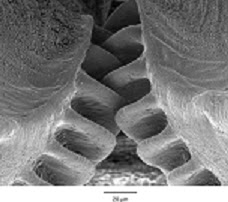Ask any mechanical engineer (for example me) what gears are, and he will answer that these are the most common drive components in our world, that the knowledge to design them is based on theories and formulas, and that the feasibility of their production requires elaborate and precise systems and machines. So it turns out that here, too, nature was probably ahead of us...

By: Ziv Kohani
Ask any mechanical engineer (for example me) what gears are, and he will answer that these are the most common drive components in our world, that the knowledge to design them is based on theories and formulas, and that the feasibility of their production requires elaborate and precise systems and machines. So it turns out that here, too, nature was probably ahead of us...
With the help of special systems for anatomical analysis and cameras with extremely high resolution and speed, researchers from the Department of Zoology at the University of Cambridge were able to identify gear systems (combined gears) within the structure of the Issus insect, which is very common in gardens in Europe. The gear system adjusts, in fact, between his legs. This proves that this mechanism existed in nature even before man developed it.
At the basic mechanical level, in order for a gear system to work efficiently and continuously, there must be a particularly precise combination of the teeth in the wheels, which fit together. The researchers discovered that this happens in the body of the insect, just like in a bicycle or a car. The researchers from Cambridge discovered that even small details, which engineers have developed over the years to prevent wear in the gears, already exist in the plant.
The insect's gears have an incredible ability to synchronize the movement of its legs. The exact timing of his movement greatly affects his ability to continue the movement of jumping forward, to the next place he wants to go.
The main researcher, Prof. Burrows, claims that a normal nerve command cannot maintain such a timed and fast mechanism, if it does not exist within such a drive mechanism. In fact, with the help of this mechanism, the insect transmits commands to activate muscles that produce force for movement. Prof. Burrows sees the insect's gears as proof of the claim that the skeleton in the insect department is a compensation for the limited abilities of the brain and their nervous system.
Another interesting mechanical parallel is that a gear system is known to malfunction when one of the wheel teeth breaks, and the timing is compromised. In the same way, the timing of the insect's movement is compromised when one of its mechanism teeth is damaged. In this regard, it was found that a young insect can grow a new tooth in a wheel (compared to an older insect, which cannot do this).
Source of knowledge

2 תגובות
An insect is a very general description, I assume that there are also surfers here with a minimal understanding of the animal world, so I will add that it is a type of cicada from the Essen family. Although we do not have the specific type in Israel, there are similar ones that are often seen on plants in the spring and run away with a jump as soon as you approach them.
First, as said, this is an insect that jumps between plants, so the mention should be corrected as if it were a plant. Secondly, upon reaching maturity the insect loses all the teeth in the mechanism and it continues to work through friction only.
http://www.wired.co.uk/news/archive/2013-09/12/mechanical-insects